Contaminant of Emerging Concerns in Modder River Catchment of Free State: Implication for Environmental Risk and Water Sources Protection
Abstract
:1. Introduction
2. Materials and Methods
2.1. Study Location
2.2. Collection of Water Samples
2.3. Reagents and Materials
2.4. Sample Preparation and Extraction
2.5. Sample Analysis
2.6. Quality Control
2.7. Water Quality Indicators in the Modder River Catchment
2.8. Statistical Analysis and Sources Apportionment
3. Results and Discussion
3.1. Analysis of Water Quality Indicators in the Modder River Catchment
3.2. Emerging Contaminants in the Modder River Catchment
3.2.1. The Presence of Emerging Contaminants in Rivers
3.2.2. The Presence of Emerging Contaminants in Dams
3.2.3. The Presence of Emerging Contaminants in Treated Drinking Water
3.3. Emerging Contaminants Pollution Sources in the Modder River Catchment
3.3.1. Pollution Source Identification with Pearson Correlation Analysis
Identification of Pollution Source in Rivers
Identification of Pollution Source in Dams
Identification of Pollution Source in Treated Drinking Water
3.3.2. Pollution Source Identification with Hierarchical Cluster Analysis
Identification of Pollution Sources in Rivers
Identification of Pollution Sources in Dams
Identification of Pollution Sources in Treated Drinking Water
3.4. Interventions to Inhibit Water Pollution for Environmental Protection and Sustainability
3.4.1. Wastewater Effluents Discharged in Nearby Streams
3.4.2. Illegal Dumping of Domestic Waste near Water Bodies
3.4.3. Emission from Domestic Sewage Overflow
3.4.4. Emission from Urban Surface Runoff
3.4.5. Emission from Agricultural Activities
4. Conclusions
5. Limitation and Future Studies
Supplementary Materials
Funding
Data Availability Statement
Acknowledgments
Conflicts of Interest
References
- Isah, A. Application of Multivariate Methods for Assessment of Variations in Rivers/Streams Water Quality in Niger State, Nigeria. Am. J. Theor. Appl. Stat. 2013, 2, 176. [Google Scholar] [CrossRef]
- Bonecker, C.C.; Diniz, L.P.; Braghin, L.d.S.M.; Mantovano, T.; da Silva, J.V.F.; Bomfim, F.d.F.; Moi, D.A.M.A.; Deosti, S.; dos Santos, G.N.T.; das Candeias, D.A.; et al. Synergistic effects of natural and anthropogenic impacts on zooplankton diversity in a subtropical floodplain: A long-term study. Oecologia Aust. 2020, 24, 524–537. [Google Scholar] [CrossRef]
- Ma, X.; Wang, L.; Yang, H.; Li, N.; Gong, C. Spatiotemporal Analysis of Water Quality Using Multivariate Statistical Techniques and the Water Quality Identification Index for the Qinhuai River Basin, East China. Water 2020, 12, 2764. [Google Scholar] [CrossRef]
- Wang, Q.; Wu, X.; Zhao, B.; Qin, J.; Peng, T. Combined multivariate statistical techniques, Water Pollution Index (WPI) and daniel trend test methods to evaluate temporal and spatial variations and trends of water quality at Shanchong River in the Northwest Basin of Lake Fuxian, China. PLoS ONE 2015, 10, e0118590. [Google Scholar] [CrossRef]
- Yang, G.; Fan, M.; Zhang, G. Emerging contaminants in surface waters in China—A short review. Environ. Res. Lett. 2014, 9, 074018. [Google Scholar] [CrossRef]
- Huang, W.; Lv, W.; Yuan, Q.; Zhou, W.; Li, T.; Dong, B. Effects of Long-Term Exposure of Pharmaceuticals and Personal Care Products on Algogenic Organic Matter Characteristics. Water 2023, 15, 2447. [Google Scholar] [CrossRef]
- Visca, A.; Caracciolo, A.B.; Grenni, P.; Rolando, L.; Mariani, L.; Rauseo, J.; Spataro, F.; Monostory, K.; Sperlagh, B.; Patrolecco, L. Legacy and Emerging Pollutants in an Urban River Stretch and Effects on the Bacterioplankton Community. Water 2021, 13, 3402. [Google Scholar] [CrossRef]
- Sililo, O.T.N.; Saayman, I.C.; Fey, M.V. Groundwater Vulnerability to Pollution in Urban Catchments; Report No. 1008/1/01; Water Research Commission: Pretoria, South Africa, 2001. [Google Scholar]
- Pretorius, E.; Gericke, O.J.; Slabbert, S.W.; Dent, M. Catchment hydrology management using GIS: Case study of the Modder River Basin, South Africa. WIT Trans. Ecol. Environ. 2005, 83, 305–314. [Google Scholar]
- Tsokeli, R.D. An Evaluation of the Spatial Variability of Sediment Sources along the Banks of the Modder River, Free State, South Africa. Master’s Thesis, University of Free State, Bloemfontein, South Africa, 2005. [Google Scholar]
- Oke, S.A.; Alowo, R. Groundwater of the Modder River Catchment of South Africa: A Sustainability Prediction. Water 2021, 13, 936. [Google Scholar] [CrossRef]
- Lin, X.; Xu, J.; Keller, A.A.; He, L.; Gu, Y.; Zheng, W.; Sun, D.; Lu, Z.; Huang, J.; Huang, X.; et al. Occurrence and risk assessment of emerging contaminants in a water reclamation and ecological reuse project. Sci. Total. Environ. 2020, 744, 140977. [Google Scholar] [CrossRef]
- Enyigwe, M.T.; Onwuka, O.S.; Egbueri, J.C. Geochemical distribution, statistical and health risk assessment of toxic elements in groundwater from a typical mining district in Nigeria. Environ. Forensics 2022, 23, 469–481. [Google Scholar] [CrossRef]
- World Health Organisation (WHO). Progress on Drinking Water, Sanitation and Hygiene. 2017. Available online: https://apps.who.int/iris/bitstream/handle/10665/258617/9789241512893-eng.pdf?sequence=1 (accessed on 26 August 2023).
- Madikizela, L.M.; Ncube, S.; Chimuka, L. Analysis, Occurrence and Removal of Pharmaceuticals in African Water Resources: A Current Status. J. Environ. Manag. 2020, 253, 109741. [Google Scholar] [CrossRef]
- Vumazonke, S.; Khamanga, S.M.; Ngqwala, N.P. Detection of Pharmaceutical Residues in Surface Waters of the Eastern Cape Province. Int. J. Environ. Res. Public Health 2020, 17, 4067. [Google Scholar] [CrossRef] [PubMed]
- Madikizela, L.M.; Ncube, S. Occurrence and Ecotoxicological Risk Assessment of Non-steroidal Anti-inflammatory Drugs in South African Aquatic Environment: What Is Known and the Missing Information? Chemosphere 2021, 280, 130688. [Google Scholar] [CrossRef] [PubMed]
- Mashile, G.P.; Mpupa, A.; Nomngongo, P.N. Magnetic Mesoporous Carbon/β-Cyclodextrin–Chitosan Nanocomposite for Extraction and Preconcentration of Multi-Class Emerging Contaminant Residues in Environmental Samples. Nanomaterials 2021, 11, 540. [Google Scholar] [CrossRef]
- Ojemaye, C.Y.; Pampanin, D.M.; Sydnes, M.O.; Green, L.; Petrik, L. The burden of emerging contaminants upon an Atlantic Ocean marine protected reserve adjacent to Camps Bay, Cape Town, South Africa. Heliyon 2022, 8, e12625. [Google Scholar] [CrossRef] [PubMed]
- Wilkinson, J.L.; Boxall, A.B.A.; Kolpin, D.W.; Leung, K.M.Y.; Lai, R.W.S.; Galbán-Malagón, C.; Adell, A.D.; Mondon, J.; Metian, M.; Marchant, R.A.; et al. Pharmaceutical pollution of the world’s rivers. Proc. Natl. Acad. Sci. USA 2022, 119, e2113947119. [Google Scholar] [CrossRef]
- Shrestha, S.; Kazama, F. Assessment of surface water quality using multivariate statistical techniques: A case study of the Fuji river basin, Japan. Environ. Model. Softw. 2007, 22, 464–475. [Google Scholar] [CrossRef]
- Selvaraju, N.; Pushpavanam, S.; Anu, N. A holistic approach combining factor analysis, positive matrix factorization, and chemical mass balance applied to receptor modeling. Environ. Monit. Assess. 2013, 185, 10115–10129. [Google Scholar] [CrossRef]
- Chen, X.; Zhu, L.; Pan, X.; Fang, S.; Zhang, Y.; Yang, L. Isomeric specific partitioning behaviors of perfluoroalkyl substances in water dissolved phase, suspended particulate matters and sediments in Liao River Basin and Taihu Lake, China. Water Res. 2015, 80, 235–244. [Google Scholar] [CrossRef]
- Chen, J.; Li, F.; Fan, Z.; Wang, Y. Integrated Application of Multivariate Statistical Methods to Source Apportionment of Watercourses in the Liao River Basin, Northeast China. Int. J. Environ. Res. Public Health 2016, 13, 1035. [Google Scholar] [CrossRef] [PubMed]
- Hong, L.; Meng, X.; Bao, T.; Liu, B.; Wang, Q.; Jin, J.; Wu, K. Spatial–Temporal Distribution and Ecological Risk Assessment of Microplastics in the Shiwuli River. Water 2023, 15, 2330. [Google Scholar] [CrossRef]
- Molaba, G.L. Investigating the Possibility of Targeting Major Dolerite Intrusives to Supplement Municipal Water Supply in Bloemfontein: A Geophysical Approach. Master’s Thesis, University of the Free State, Bloemfontein, South Africa, 2017. [Google Scholar]
- Woyessa, Y.; Hensley, M.; Van Rensburg, L. Catchment management in semi-arid area of central South Africa: Strategy for improving water productivity. Water SA 2006, 32, 648–654. [Google Scholar] [CrossRef]
- Mangaung Metropolitan Municipality Integrated Development Plan (MMM). Final Integrated Plan 2022/2027. 2022. Available online: http://www.mangaung.co.za/wp-content/uploads/2022/05/2-Final-IDP-2022-2027-24.05.2022-Signed.pdf (accessed on 29 July 2023).
- Odendaal, C.; Seaman, M.T.; Kemp, G.; Patterton, H.E.; Patterton, H.G. An LC-MS/MS based survey of contaminants of emerging concern in drinking water in South Africa. South Afr. J. Sci. 2015, 111, 6. [Google Scholar] [CrossRef] [PubMed]
- Mugudamani, I.; Oke, S.A.; Gumede, T.P.; Senbore, S. Herbicides in Water Sources: Communicating Potential Risks to the Population of Mangaung Metropolitan Municipality, South Africa. Toxics 2023, 11, 538. [Google Scholar] [CrossRef] [PubMed]
- Birajdar, S.N.; Vedpathak, S.G.; Chanshetti, U.B. The Effect of Seasonal Variation on Physicochemical Properties of Tubewell Water of Latur District (MS), India. IOSR J. Environ. Sci. Toxicol. Food Technol. 2017, 11, 58–63. [Google Scholar]
- SANS 241-1; Drinking Water, Part 1: Microbiological, Physical, Aesthetic and Chemical Determinants. SABS: Pretoria, South Africa, 2015.
- World Health Organization (WHO). Guidelines for Drinking Water Quality; World Health Organization: Geneva, Switzerland, 2015; Available online: https://www.who.int/publications-detail-redirect/9789241549950 (accessed on 2 October 2013).
- Lutovac, M.; Popova, O.V.; Macanovic, G.; Kristina, R.; Lutovac, B.; Ketin, S.; Biocanin, R. Testing the Effect of Aggressive Beverage on the Damage of Enamel Structure. Maced. J. Med.Sci. 2017, 15, 987–993. [Google Scholar] [CrossRef] [PubMed]
- Gintamo, B.; Khan, M.A.; Gulilat, H.; Shukla, R.K.; Mekonnen, Z. Determination of the Physicochemical Quality of Groundwater and its Potential Health Risk for Drinking in Oromia, Ethiopia. Environ. Health Insights 2022, 16, 1–11. [Google Scholar] [CrossRef]
- Shoeb, M.; Sharmin, F.; Islam, N.; Nahar, L.; Islam, R.; Parvin, N. Assessment of Physico-Chemical Parameters of Water Samples Collected from the Southern Part of Bangladesh. Dhaka Univ. J. Sci. 2022, 70, 49–57. [Google Scholar] [CrossRef]
- Khan, M.A.; Wen, J. Evaluation of physicochemical and heavy metals characteristics in surface water under anthropogenic activities using multivariate statistical methods, Garra River, Ganges Basin, India. Environ. Eng. Res. 2021, 26, 200280. [Google Scholar] [CrossRef]
- USGS (United State Geological Survey). Temperature and Water. 2015. Available online: https://www.usgs.gov/special-topics/water-science-school/science/temperature-and-water#:~:text=Warm%20water%20holds%20less%20dissolved,aquatic%20life%20at%20higher%20temperatures (accessed on 2 March 2023).
- Dallas, H. Water temperature and riverine ecosystems: An overview of knowledge and approaches for assessing biotic responses, with special reference to South Africa. Water SA 2008, 34, 393–404. [Google Scholar] [CrossRef]
- Soylak, M.; Aydin, F.A.; Saracoglu, S.; Elci, L.; Dogan, M. Chemical analysis of drinking water samples from Yozgat, Turkey. Polish J. Environ. Stud. 2002, 11, 151–156. [Google Scholar]
- Meride, Y.; Ayenew, B. Drinking water quality assessment and its effects on residents health in Wondo genet campus, Ethiopia. Environ. Syst. Res. 2016, 5, 1. [Google Scholar] [CrossRef]
- Gandaseca; Gandaseca, S.; Rosli, N.; Hossain, M.S.; Arianto, C.I. Assessment of oil palm plantation and tropical peat swamp forest water quality by multivariate statistical analysis. Am. J. Environ. Sci. 2014, 10, 391–402. [Google Scholar] [CrossRef]
- United State Environmental Protection Agency (USEPA). Water Quality Standards Handbook, 2nd ed.; USEPA: Washington, DC, USA, 1993. Available online: https://nepis.epa.gov/Exe/ZyPDF.cgi/20003QXV.PDF?Dockey=20003QXV.PDF (accessed on 3 July 2023).
- Worako, A.W. Physicochemical and biological water quality assessment of Lake Hawassa for multiple designated water uses. J. Urban Environ. Eng. 2015, 9, 146–157. [Google Scholar] [CrossRef]
- Makhadi, R.; Oke, S.A.; Ololade, O.O. The Influence of Non-Engineered Municipal Landfills on Groundwater Chemistry and Quality in Bloemfontein, South Africa. Molecules 2020, 25, 5599. [Google Scholar] [CrossRef]
- Zhang, S.; Zhang, Q.; Darisaw, S.; Ehie, O.; Wang, G. Simultaneous quantification of polycyclic aromatic hydrocarbons (PAHs), polychlorinated biphenyls (PCBs), and pharmaceuticals and personal care products (PPCPs) in Mississippi river water, in New Orleans, Louisiana, USA. Chemosphere 2006, 66, 1057–1069. [Google Scholar] [CrossRef]
- Tran, N.H.; Urase, T.; Ta, T.T. A Preliminary Study on the Occurrence of Pharmaceutically Active Compounds in Hospital Wastewater and Surface Water in Hanoi, Vietnam. Clean Soil Air Water 2014, 42, 267–275. [Google Scholar] [CrossRef]
- Yan, Q.; Zhang, Y.; Kang, J.; Gan, X.; Xu, Y.P.; Guo, J.; Gao, X. A Preliminary Study on the Occurrence of Pharmaceutically Active Compounds in the River Basins and Their Removal in Two Conventional Drinking Water Treatment Plants in Chongqing, China. Clean Soil Air Water 2015, 43, 794–803. [Google Scholar] [CrossRef]
- Agunbiade, F.O.; Moodley, B. Occurrence and distribution pattern of acidic pharmaceuticals in surface water, wastewater, and sediment of the Msunduzi River, Kwazulu-Natal, South Africa. Environ. Toxicol. Chem. 2016, 35, 36–46. [Google Scholar] [CrossRef]
- Mhuka, V.; Dube, S.; Nindi, M.M. Occurrence of pharmaceutical and personal care products (PPCPs) in wastewater and receiving waters in South Africa using LC-Orbitrap™ MS. Emerg. Contam. 2020, 6, 250–258. [Google Scholar] [CrossRef]
- Wanda, E.M.M.; Nyoni, H.; Mamba, B.B.; Msagati, T.A.M. Occurrence of emerging micropollutants in water systems in Gauteng, Mpumalanga and North West provinces, South Africa. Int. J. Environ. Res. Public Health 2017, 14, 79. [Google Scholar] [CrossRef] [PubMed]
- Archer, E.; Wolfaardt, G.M.; Van Wyk, J.H. Review: Pharmaceutical and personal care products (PPCPs) as endocrine disrupting contaminants (EDCs) in South African surface waters. Water SA 2017, 43, 684. [Google Scholar] [CrossRef]
- Glassmeyer, S.T.; Furlong, E.T.; Kolpin, D.W.; Batt, A.L.; Benson, R.; Boone, J.S.; Conerly, O.; Donohue, M.J.; King, D.N.; Kostich, M.S.; et al. Nationwide reconnaissance of contaminants of emerging concern in source and treated drinking waters of the United States. Sci. Total. Environ. 2016, 581–582, 909–922. [Google Scholar] [CrossRef] [PubMed]
- Hossain, A.; Nakamichi, S.; Habibullah-Al-Mamun, M.; Tani, K.; Masunaga, S.; Matsuda, H. Occurrence and Ecological Risk of Pharmaceuticals in River Surface Water of Bangladesh. Environ. Res. 2018, 165, 258–266. [Google Scholar] [CrossRef]
- Ekinci, M.; Ciftci, B.; Celik, E.C.; Köse, E.A.; Karakaya, M.A.; Ozdenkaya, Y. A randomized, placebo-controlled, double-blind study that evaluates efficacy of intravenous ibuprofen and acetaminophen for postoperative pain treatment following laparoscopic cholecystectomy surgery. J. Gastrointest. Surg. 2020, 24, 780–788. [Google Scholar] [CrossRef]
- Nannou, C.; Ofrydopoulou, A.; Evgenidou, E.; Heath, D.; Heath, E.; Lambropoulou, D. Antiviral drugs in aquatic environment and wastewater treatment plants: A review on occurrence, fate, removal and ecotoxicity. Sci. Total. Environ. 2020, 699, 134322. [Google Scholar] [CrossRef]
- Sorensen, J.P.R.; Lapworth, D.J.; Nkhuwa, D.C.W.; Stuart, M.E.; Gooddy, D.C.; Bell, R.A.; Chirwa, M.; Kabika, J.; Liemisa, M.; Chibesa, M.; et al. Emerging contaminants in urban groundwater sources in Africa. Water Res. 2014, 72, 51–63. [Google Scholar] [CrossRef]
- Correia, N.M.; Carbonari, C.A.; Velini, E.D. Detection of herbicides in water bodies of the Samambaia River sub-basin in the Federal District and eastern Goiás. J. Environ. Sci. Health Part B 2020, 55, 574–582. [Google Scholar] [CrossRef]
- Curchod, L.; Oltramare, C.; Junghans, M.; Stamm, C.; Dalvie, M.A.; Röösli, M.; Fuhrimann, S. Temporal variation of pesticide mixtures in rivers of three agricultural watersheds during a major drought in the Western Cape, South Africa. Water Res. 2020, 6, 100039. [Google Scholar] [CrossRef]
- Wang, M.; Lv, J.; Deng, H.; Liu, Q.; Liang, S. Occurrence and Removal of Triazine Herbicides during Wastewater Treatment Processes and Their Environmental Impact on Aquatic Life. Int. J. Environ. Res. Public Health 2022, 19, 4557. [Google Scholar] [CrossRef] [PubMed]
- Montagner, C.C.; Jardim, W.F. Spatial and seasonal variations of pharmaceuticals and endocrine disruptors in the Atibaia River, São Paulo State (Brazil). J. Braz. Chem. Soc. 2011, 22, 1452–1462. [Google Scholar] [CrossRef]
- Olarinmoye, O.; Bakare, A.; Ugwumba, O.; Hein, A. Quantification of pharmaceutical residues in wastewater impacted surface waters and sewage sludge from Lagos, Nigeria. J. Environ. Chem. Ecotoxicol. 2016, 8, 14–24. [Google Scholar] [CrossRef]
- Pivetta, G.G.; Gastaldini, M.D.C.C. Presence of emerging contaminants in urban water bodies in southern Brazil. J. Water Health 2019, 17, 329–337. [Google Scholar] [CrossRef] [PubMed]
- Tan, R.; Liu, R.; Li, B.; Liu, X.; Li, Z. Typical Endocrine Disrupting Compounds in Rivers of Northeast China: Occurrence, Partitioning, and Risk Assessment. Arch. Environ. Contam. Toxicol. 2018, 75, 213–223. [Google Scholar] [CrossRef]
- Forghani, M.; Sadeghi, G.; Peyda, M. The presence of 17 beta-estradiol in the environment: Health effects and increasing environmental concerns. Int. J. Epidemiol. Res. 2018, 5, 151–158. [Google Scholar] [CrossRef]
- Rimayi, C.; Odusanya, D.; Weiss, J.M.; de Boer, J.; Chimuka, L. Seasonal variation of chloro-s-triazines in the Hartbeespoort Dam catchment, South Africa. Sci. Total. Environ. 2018, 613–614, 472–482. [Google Scholar] [CrossRef]
- Chen, H.-C.; Wang, P.-L.; Ding, W.-H. Using liquid chromatography–ion trap mass spectrometry to determine pharmaceutical residues in Taiwanese rivers and wastewaters. Chemosphere 2008, 72, 863–869. [Google Scholar] [CrossRef] [PubMed]
- Agunbiade, F.O.; Moodley, B. Pharmaceuticals as emerging organic contaminants in Umgeni River water system, KwaZulu-Natal, South Africa. Environ. Monit. Assess. 2014, 186, 7273–7291. [Google Scholar] [CrossRef]
- Kanama, K.M.; Daso, A.P.; Mpenyana-Monyatsi, L.; Coetzee, M.A.A. Assessment of pharmaceuticals, personal care products, and hormones in wastewater treatment plants receiving inflows from health facilities in North West Province. South Africa. J. Toxicol. 2018, 2018, 3751930. [Google Scholar] [CrossRef]
- Fairbairn, D.J.; Karpuzcu, M.E.; Arnold, W.A.; Barber, B.L.; Kaufenberg, E.F.; Koskinen, W.C.; Novak, P.J.; Rice, P.J.; Swackhamer, D.L. Sediment–water distribution of contaminants of emerging concern in a mixed use watershed. Sci. Total. Environ. 2014, 505, 896–904. [Google Scholar] [CrossRef] [PubMed]
- Ojemaye, C.Y. Identification and Quantification of Chemicals of Emerging Concern (Persistent Organic and Inorganic Pollutants) in Some Selected Marine Environments of Cape Town, South Africa. Ph.D. Thesis, University of the Western Cape, Cape Town, South Africa, 2020. [Google Scholar]
- Pandey, P.; Caudill, J.; Lesmeister, S.; Zheng, Y.; Wang, Y.; Stillway, M.; Hoffmann, K.; Gilbert, P.; Kwong, M.; Conrad, L.; et al. Assessing Glyphosate and Fluridone Concentrations in Water Column and Sediment Leachate. Front. Environ. Sci. 2019, 7, 22. [Google Scholar] [CrossRef]
- Ogunbanwo, O.M.; Kay, P.; Boxall, A.B.; Wilkinson, J.; Sinclair, C.J.; Shabi, R.A.; Fasasi, A.E.; Lewis, G.A.; Amoda, O.A.; Brown, L.E. High Concentrations of Pharmaceuticals in a Nigerian River Catchment. Environ. Toxicol. Chem. 2020, 41, 551–558. [Google Scholar] [CrossRef] [PubMed]
- Machado, K.C.; Grassi, M.T.; Vidal, C.; Pescara, I.C.; Jardim, W.F.; Fernandes, A.N.; Sodré, F.F.; Almeida, F.V.; Santana, J.S.; Canela, M.C.; et al. A preliminary nationwide survey of the presence of emerging contaminants in drinking and source waters in Brazil. Sci. Total. Environ. 2016, 572, 138–146. [Google Scholar] [CrossRef]
- Van Zijl, M.C.; Aneck-Hahn, N.H.; Swart, P.; Hayward, S.; Genthe, B.; De Jager, C. Estrogenic activity, chemical levels and health risk assessment of municipal distribution point water from Pretoria and Cape Town, South Africa. Chemosphere 2017, 186, 305–313. [Google Scholar] [CrossRef] [PubMed]
- Almberg, K.S.; Turyk, M.E.; Jones, R.M.; Rankin, K.; Freels, S.; Stayner, L.T. Atrazine Contamination of Drinking Water and Adverse Birth Outcomes in Community Water Systems with Elevated Atrazine in Ohio, 2006–2008. Int. J. Environ. Res. Public Health 2018, 15, 1889. [Google Scholar] [CrossRef] [PubMed]
- Department of Water Affairs and Forestry (DWAF). South African Water Quality Guidelines Volume 1: Domestic Water Use, 2nd ed.; DWAF: Pretoria, South Africa, 1998. [Google Scholar]
- Horak, I.; Horn, S.; Pieters, R. Agrochemicals in freshwater systems and their potential as endocrine disrupting chemicals: A South African context. Environ. Pollut. 2021, 268, 115718. [Google Scholar] [CrossRef]
- Hamilton, D.; Dieterle, R.; Felsot, A.; Harris, C.; Holland, P.; Katayama, A.; Kurihara, N.; Linders, J.; Unsworth, J.; Wong, S.S. Regulatory limits for pesticides residues in water (IUPAC Technical Report). Pure Appl. Chem. 2003, 75, 1123–1155. [Google Scholar] [CrossRef]
- Syafrudin, M.; Kristanti, R.A.; Yuniarto, A.; Hadibarata, T.; Rhee, J.; Al-Onazi, W.A.; Algarni, T.S.; Almarri, A.H.; Al-Mohaimeed, A.M. Pesticides in drinking water—A review. Int. J. Environ. Res. Public Health 2021, 18, 468. [Google Scholar] [CrossRef]
- Stefanakis, A.I.; Becker, J.A. A review of emerging contaminants in water: Classification, sources, and potential risks. In Impact of Water Pollution on Human Health and Environmental Sustainability; Mckeown, A.E., Ed.; IGI Global: Hershey, PA, USA, 2016; pp. 55–80. [Google Scholar]
- Chen, H.-Y.; Teng, Y.-G.; Wang, J.-S.; Song, L.-T. Source Apportionment of Water Pollution in the Jinjiang River (China) Using Factor Analysis with Nonnegative Constraints and Support Vector Machines. Environ. Forensics 2012, 13, 175–184. [Google Scholar] [CrossRef]
- Mugudamani, I.; Oke, S.A.; Gumede, T.P. Influence of Urban Informal Settlements on Trace Element Accumulation in Road Dust and Their Possible Health Implications in Ekurhuleni Metropolitan Municipality, South Africa. Toxics 2022, 10, 253. [Google Scholar] [CrossRef] [PubMed]
- Li, C.; Wang, X.; Xiao, S.; Wang, H. The Source Apportionment of Heavy Metals in Surface Dust in the Main District Bus Stops of Tianshui City Based on the Positive Matrix Factorization Model and Geo-Statistics. Atmosphere 2023, 14, 591. [Google Scholar] [CrossRef]
- Zhao, L.; Hu, G.; Yan, Y.; Yu, R.; Cui, J.; Wang, X.; Yan, Y. Source apportionment of heavy metals in urban road dust in a continental city of eastern China: Using Pb and Sr isotopes combined with multivariate statistical analysis. Atmos. Environ. 2019, 201, 201–211. [Google Scholar] [CrossRef]
- Rashid, A.; Ayub, M.; Ullah, Z.; Ali, A.; Khattak, S.A.; Ali, L.; Gao, X.; Li, C.; Khan, S.; El-Serehy, H.A.; et al. Geochemical Modeling Source Provenance, Public Health Exposure, and Evaluating Potentially Harmful Elements in Groundwater: Statistical and Human Health Risk Assessment (HHRA). Int. J. Environ. Res. Public Health 2022, 19, 6472. [Google Scholar] [CrossRef] [PubMed]
- Yang, Z.; Zhang, M.; Hao, C.; Hou, X.; Wang, L.; Xia, R.; Yin, J.; Ma, C.; Wang, Q.; Zhang, Y. Source apportionment of total phosphorus pollution in Poyang lake basin based on source sink process modeling. Res. Environ. Sci. 2020, 33, 2493–2506. [Google Scholar]
- Hou, X.; Gao, W.; Zhang, M.; Xia, R.; Zhang, Y.; Zhang, K.; Wang, X.; Yang, K.; Chen, X.; Deng, Y. Source apportionment of water pollutants in Poyang Lake Basin in China using absolute principal component score–multiple linear regression model combined with land-use parameters. Front. Environ. Sci. 2022, 10, 924350. [Google Scholar] [CrossRef]
- Das, A. Multivariate Statistical Approach for the Assessment of Water Quality of Mahanadi Basin, Odisha. Mater. Today Proc. 2022, 65, A1–A11. [Google Scholar]
- Atangana, M.S.B.; Ngoupayou, J.R.N.; Deliege, J.-F. Hydrogeochemistry and Mercury Contamination of Surface Water in the Lom Gold Basin (East Cameroon): Water Quality Index, Multivariate Statistical Analysis and Spatial Interpolation. Water 2023, 15, 2502. [Google Scholar] [CrossRef]
- Rashid, A.; Khan, S.; Ayub, M.; Sardar, T.; Jehan, S.; Zahir, S.; Khan, M.S.; Muhammad, J.; Khan, R.; Ali, A.; et al. Mapping human health risk from exposure to potential toxic metal contamination in groundwater of Lower Dir, Pakistan: Application of multivariate and geographical information system. Chemosphere 2019, 225, 785–795. [Google Scholar] [CrossRef]
- Gosset, A.; Wiest, L.; Fildier, A.; Libert, C.; Giroud, B.; Hammada, M.; Hervé, M.; Sibeud, E.; Vulliet, E.; Polomé, P.; et al. Ecotoxicological risk assessment of contaminants of emerging concern identified by “suspect screening” from urban wastewater treatment plant effluents at a territorial scale. Sci. Total Environ. 2021, 778, 146275. [Google Scholar] [CrossRef]
- Caban, M.; Stepnowski, P. How to decrease pharmaceuticals in the environment? A review. Environ. Chem. Lett. 2021, 19, 3115–3138. [Google Scholar] [CrossRef]
- Gozzo, S.; Moles, S.; Kińska, K.; Ormad, M.P.; Mosteo, R.; Gómez, J.; Laborda, F.; Szpunar, J. Screening for Antibiotics and Their Degradation Products in Surface and Wastewaters of the POCTEFA Territory by Solid-Phase Extraction-UPLC-Electrospray MS/MS. Water 2023, 15, 14. [Google Scholar] [CrossRef]
- Bourgin, M.; Beck, B.; Boehler, M.; Borowska, E.; Fleiner, J.; Salhi, E.; Teichler, R.; von Gunten, U.; Siegrist, H.; McArdell, C.S. Evaluation of a full-scale wastewater treatment plant upgraded with ozonation and biological post-treatments: Abatement of micropollutants, formation of transformation products and oxidation by-products. Water Res. 2018, 129, 486–498. [Google Scholar] [CrossRef] [PubMed]
- Kihila, J.M.; Wernsted, K.; Kaseva, M. Waste segregation and potential for recycling—A case study in Dar es Salaam City, Tanzania. Sustain. Environ. 2021, 7, 1935532. [Google Scholar] [CrossRef]
- Topp, E.; Monteiro, S.C.; Beck, A.; Coehlo, B.; Boxall, A.B.; Duenk, P.W.; Kleywegt, S.; Lapen, D.R.; Payne, M.; Sabourin, L.; et al. Runoff of pharmaceuticals and personal care products following application of biosolids to an agricultural field. Sci. Total Environ. 2008, 396, 52–59. [Google Scholar] [CrossRef] [PubMed]
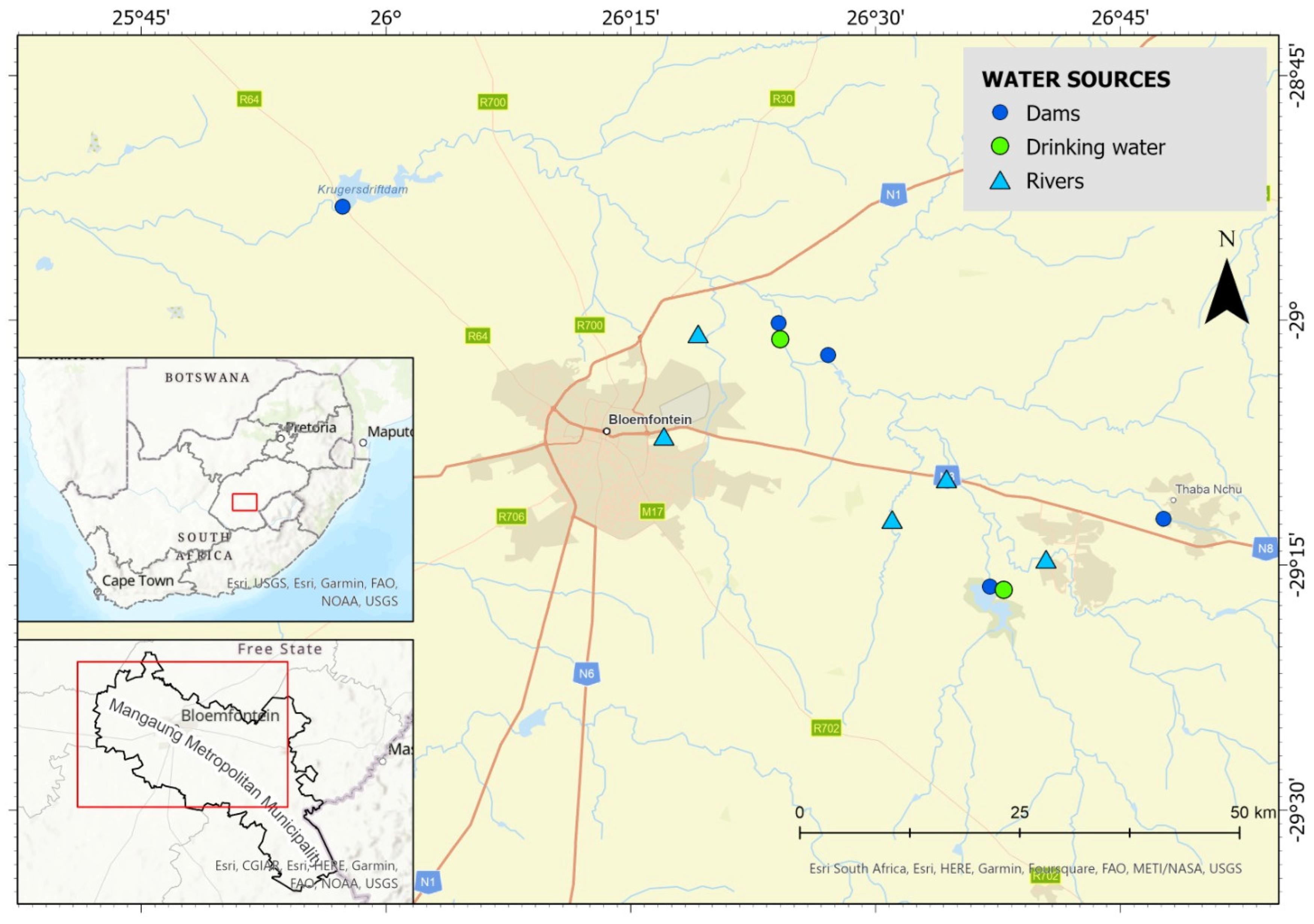
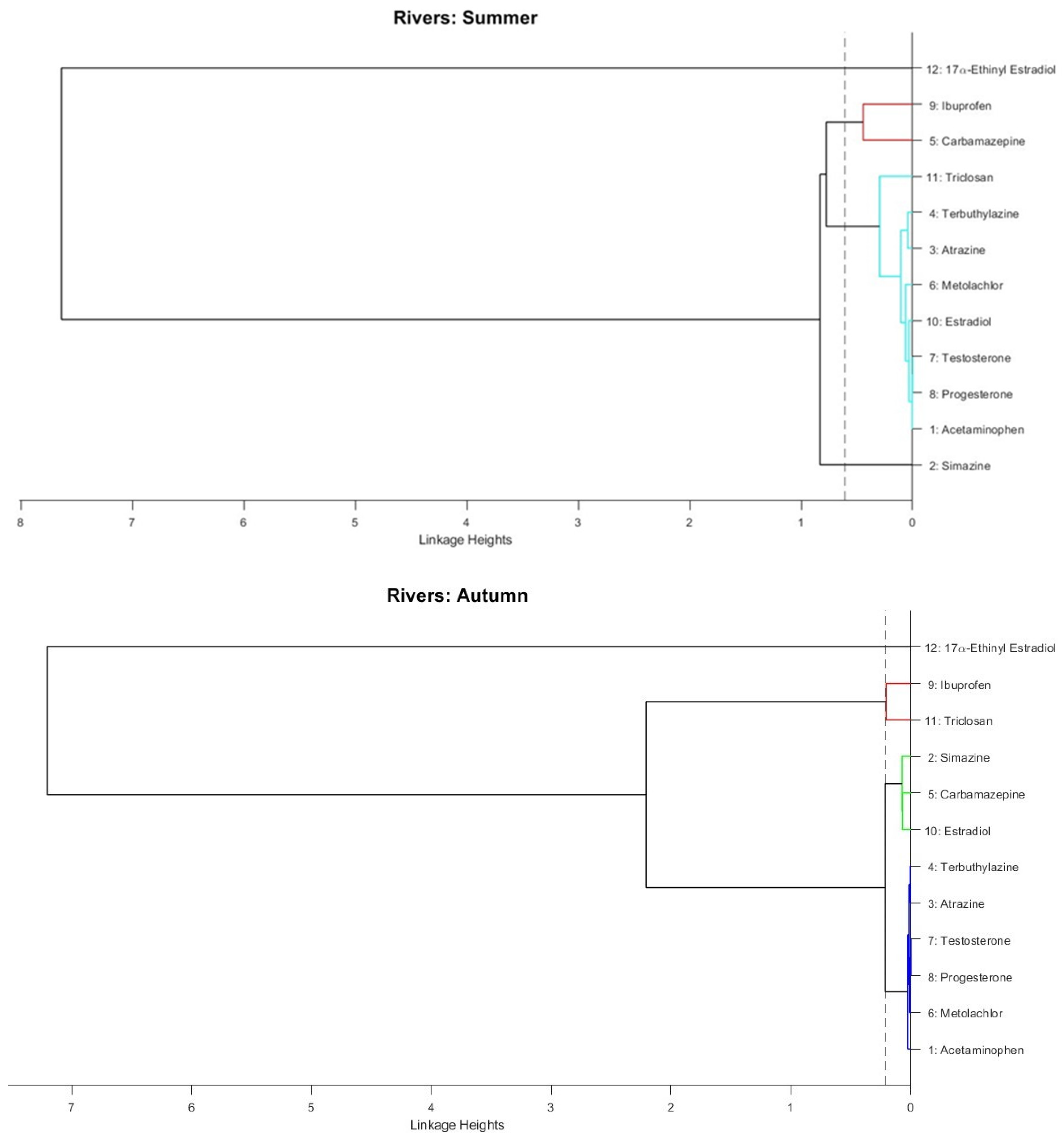
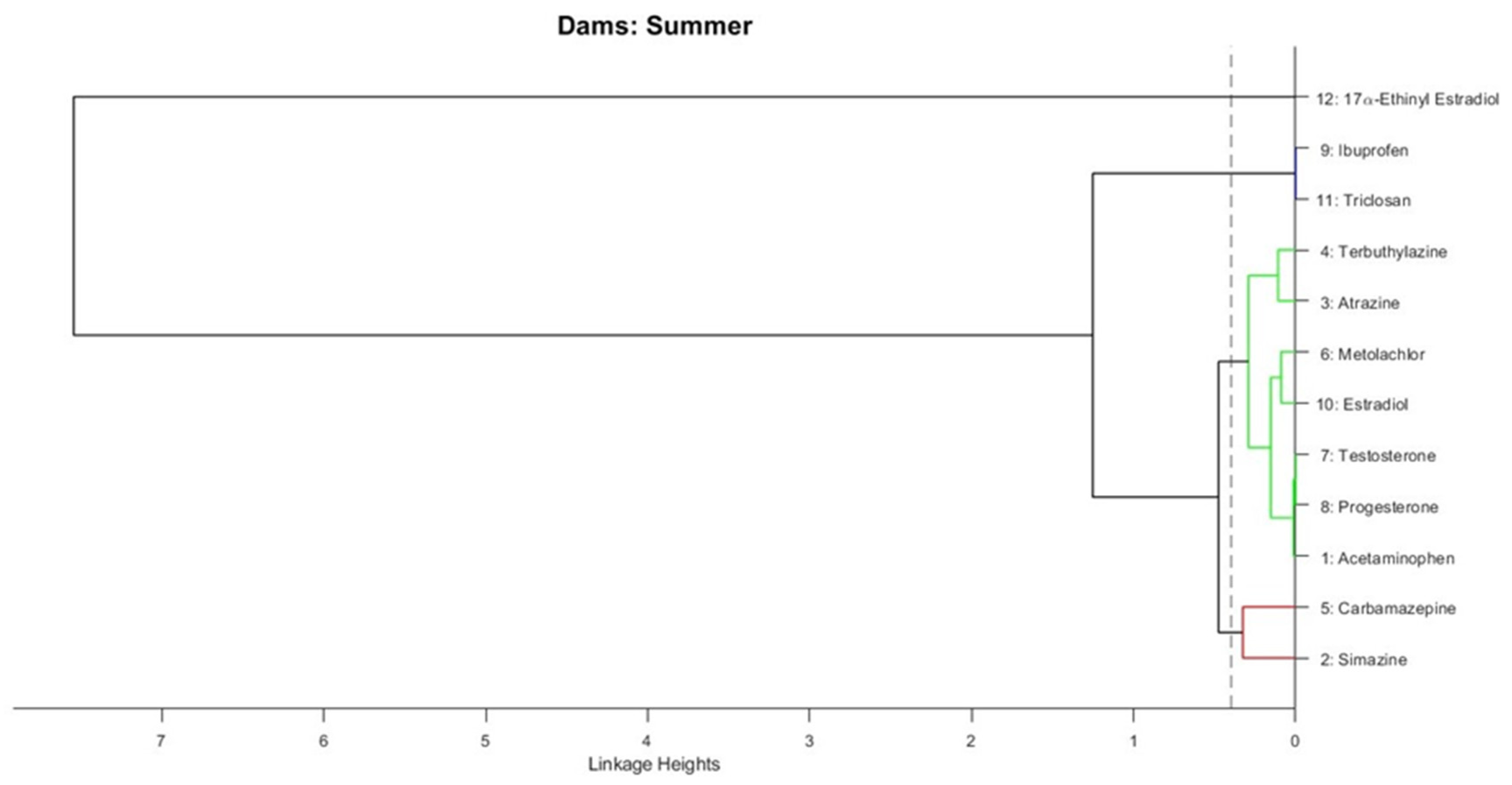
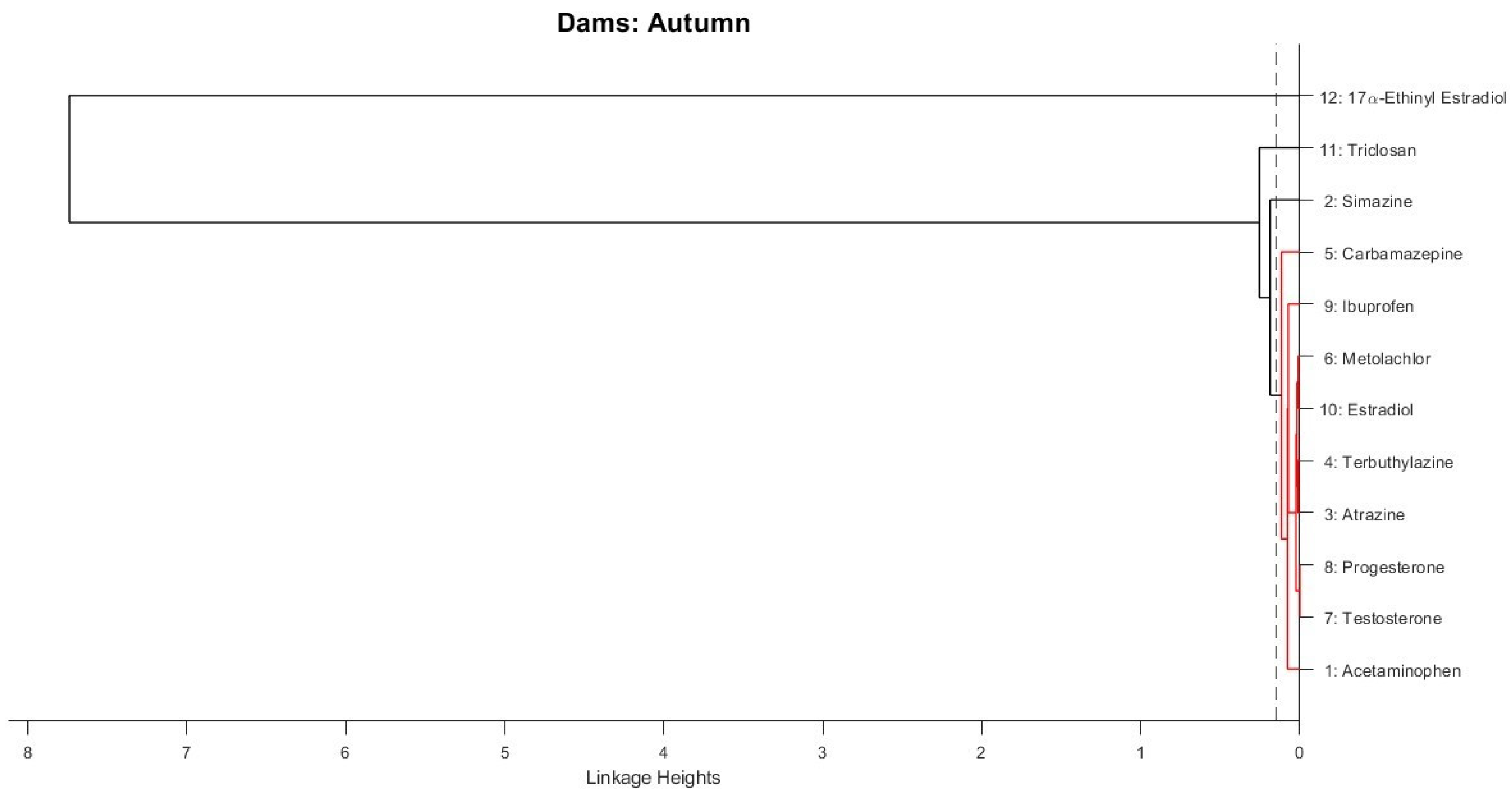
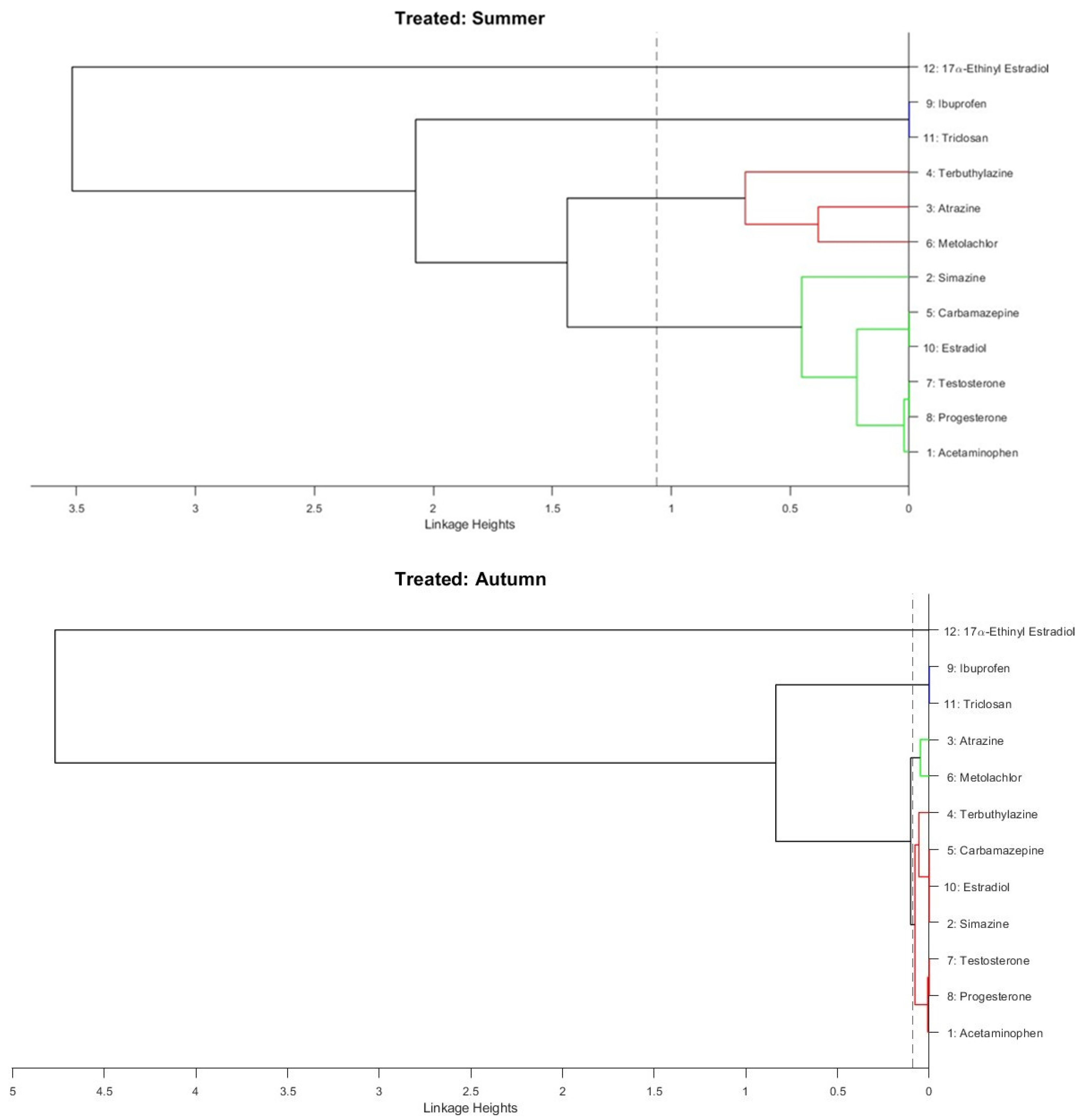
| Compound | Summer (n = 12) | Autumn (n = 12) | ||||
|---|---|---|---|---|---|---|
| DF | Min-Max | Mean/±SD | DF | Min-Max | Mean/±SD | |
| Rivers (n = 5) | ||||||
| Acetaminophen (µg/L) | 0 | <LOQ | <LOQ | 0 | <LOQ | <LOQ |
| Carbamazepine (µg/L) | 4 | 0.40–1.43 | 0.7 ± 0.49 | 4 | <LOQ–0.32 | 0.25 ± 0.07 |
| Ibuprofen (µg/L) | 4 | 0.38–2.11 | 1.16 ± 0.76 | 3 | <LOQ–2.26 | 0.92 ± 1.16 |
| Triclosan (µg/L) | 0 | <LOQ | <LOQ | 0 | <LOQ | <LOQ |
| Atrazine (mg/L) | 5 | 0.03–0.11 | 0.05 ± 0.03 | 5 | 0.0014–0.03 | 0.69 ± 0.01 |
| Metolachlor (mg/L) | 5 | 0.02–0.12 | 0.06 ± 0.04 | 5 | 0.0007–0.03 | 0.02 ± 0.01 |
| Simazine (mg/L) | 4 | 0.10–3.22 | 1.041 ± 0.48 | 2 | <LOQ–0.91 | 0.69 ± 0.30 |
| Terbuthylazine (mg/L) | 5 | 0.03–0.14 | 0.08 ± 0.05 | 5 | 0.0016–0.03 | 0.01 ± 0.01 |
| 17-alpha-ethinyl estradiol (µg/L) | 5 | 1.08–14.5 | 7.79 ± 5.34 | 4 | <LOQ–53.80 | 31.55 ± 18.79 |
| Estradiol (µg/L) | 0 | <LOQ | <LOQ | 0 | <LOQ | <LOQ |
| Progesterone (µg/L) | 0 | <LOQ | <LOQ | 0 | <LOQ | <LOQ |
| Testosterone (µg/L) | 0 | <LOQ | <LOQ | 0 | <LOQ | <LOQ |
| Dams/reservoirs (n = 5) | ||||||
| Acetaminophen (µg/L) | 0 | <LOQ | <LOQ | 1 | <LOQ–0.09 | - |
| Carbamazepine (µg/L) | 5 | 0.01–0.21 | 0.12 ± 0.08 | 5 | 0.03–0.19 | 0.08 ± 0.06 |
| Ibuprofen (µg/L) | 0 | <LOQ | <LOQ | 2 | <LOQ–0.03 | 0.02 ± 0.01 |
| Triclosan (µg/L) | 0 | <LOQ | <LOQ | 0 | <LOQ | <LOQ |
| Atrazine (mg/L) | 5 | 0.02–0.04 | 0.03 ± 0.01 | 5 | 0.003–0.02 | 0.01 ± 0.01 |
| Metolachlor (mg/L) | 5 | 0.01–0.04 | 0.03 ± 0.01 | 5 | 0.01–0.02 | 0.01 ± 0.01 |
| Simazine (mg/L) | 4 | <LOQ–0.24 | 0.13 ± 0.11 | 4 | <LOQ–0.29 | 0.12 ± 0.12 |
| Terbuthylazine (mg/L) | 5 | 0.02–0.08 | 0.05 ± 0.02 | 5 | 0.003–0.03 | 0.01 ± 0.08 |
| 17-alpha-ethinyl estradiol (µg/L) | 5 | 0.25–3.40 | 1.83 ± 1.13 | 5 | 1.30–14.80 | 6.90 ± 5.08 |
| Estradiol (µg/L) | 0 | <LOQ | <LOQ | 0 | <LOQ | <LOQ |
| Progesterone (µg/L) | 0 | <LOQ | <LOQ | 0 | <LOQ | <LOQ |
| Testosterone (µg/L) | 0 | <LOQ | <LOQ | 0 | <LOQ | <LOQ |
| Treated (tap) drinking water (n = 2) | ||||||
| Acetaminophen (µg/L) | 0 | <LOQ | <LOQ | 0 | <LOQ | <LOQ |
| Carbamazepine (µg/L) | 0 | <LOQ | <LOQ | 0 | <LOQ | <LOQ |
| Ibuprofen (µg/L) | 0 | <LOQ | <LOQ | 0 | <LOQ | <LOQ |
| Triclosan (µg/L) | 0 | <LOQ | <LOQ | 0 | <LOQ | <LOQ |
| Atrazine (mg/L) | 2 | 0.02–0.12 | 0.07 ± 0.07 | 2 | 0.01–0.03 | 0.02 ± 0.01 |
| Metolachlor (mg/L) | 2 | 0.01–0.09 | 0.05 ± 0.06 | 2 | 0.004–0.04 | 0.02 ± 0.01 |
| Simazine (mg/L) | 1 | <LOQ–0.04 | - | 0 | <LOQ | <LOQ |
| Terbuthylazine (mg/L) | 2 | 0.02–0.16 | 0.09 ± 0.10 | 2 | 0.004–0.02 | 0.01 ± 0.003 |
| 17-alpha-ethinyl estradiol (µg/L) | 2 | 0.14–0.26 | 0.2 ± 0.08 | 2 | 0.42–1.04 | 0.73 ± 0.40 |
| Estradiol (µg/L) | 0 | <LOQ | <LOQ | 0 | <LOQ | <LOQ |
| Progesterone (µg/L) | 0 | <LOQ | <LOQ | 0 | <LOQ | <LOQ |
| Testosterone (µg/L) | 0 | <LOQ | <LOQ | 0 | <LOQ | <LOQ |
Disclaimer/Publisher’s Note: The statements, opinions and data contained in all publications are solely those of the individual author(s) and contributor(s) and not of MDPI and/or the editor(s). MDPI and/or the editor(s) disclaim responsibility for any injury to people or property resulting from any ideas, methods, instructions or products referred to in the content. |
© 2024 by the author. Licensee MDPI, Basel, Switzerland. This article is an open access article distributed under the terms and conditions of the Creative Commons Attribution (CC BY) license (https://creativecommons.org/licenses/by/4.0/).
Share and Cite
Oke, S.A. Contaminant of Emerging Concerns in Modder River Catchment of Free State: Implication for Environmental Risk and Water Sources Protection. Water 2024, 16, 2494. https://doi.org/10.3390/w16172494
Oke SA. Contaminant of Emerging Concerns in Modder River Catchment of Free State: Implication for Environmental Risk and Water Sources Protection. Water. 2024; 16(17):2494. https://doi.org/10.3390/w16172494
Chicago/Turabian StyleOke, Saheed Adeyinka. 2024. "Contaminant of Emerging Concerns in Modder River Catchment of Free State: Implication for Environmental Risk and Water Sources Protection" Water 16, no. 17: 2494. https://doi.org/10.3390/w16172494







